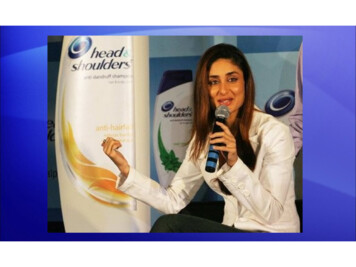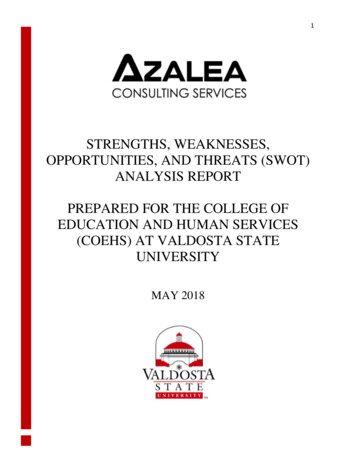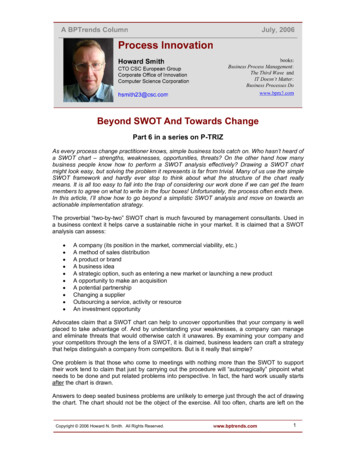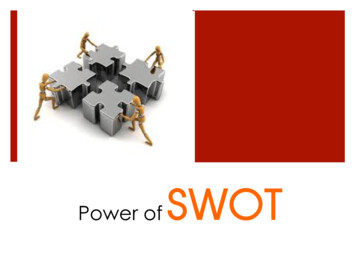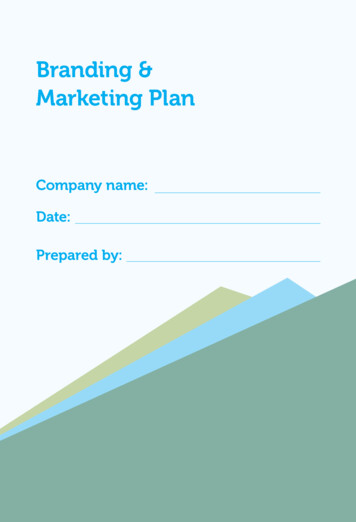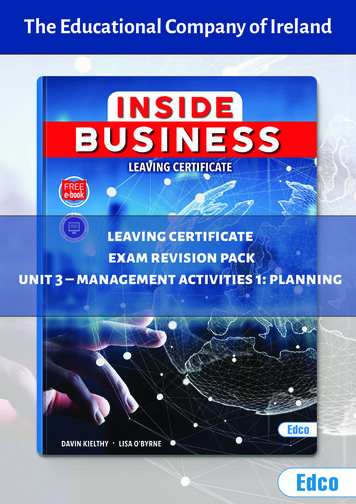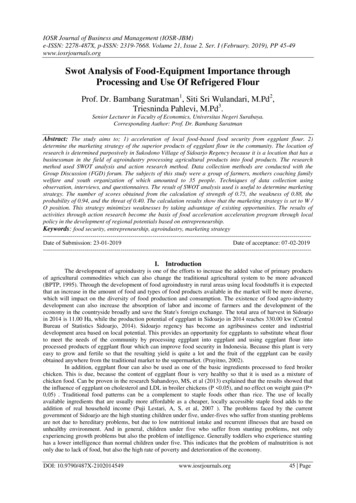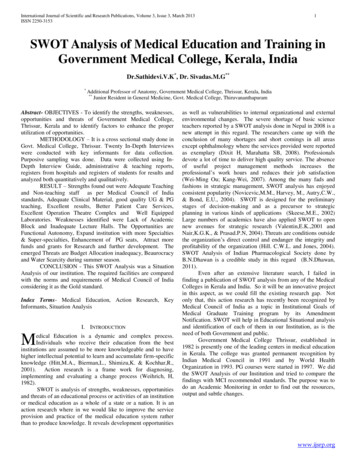
Transcription
International Journal of Scientific and Research Publications, Volume 3, Issue 3, March 2013ISSN 2250-31531SWOT Analysis of Medical Education and Training inGovernment Medical College, Kerala, IndiaDr.Sathidevi.V.K*, Dr. Sivadas.M.G***Additional Professor of Anatomy, Government Medical College, Thrissur, Kerala, India**Junior Resident in General Medicine, Govt. Medical College, ThiruvananthapuramAbstract- OBJECTIVES - To identify the strengths, weaknesses,opportunities and threats of Government Medical College,Thrissur, Kerala and to identify factors to enhance the properutilization of opportunities.METHODOLOGY – It is a cross sectional study done inGovt. Medical College, Thrissur. Twenty In-Depth Interviewswere conducted with key informants for data collection.Purposive sampling was done. Data were collected using InDepth Interview Guide, administrative & teaching reports,registers from hospitals and registers of students for results andanalyzed both quantitatively and qualitatively.RESULT – Strengths found out were Adequate Teachingand Non-teaching staff as per Medical Council of Indiastandards, Adequate Clinical Material, good quality UG & PGteaching, Excellent results, Better Patient Care Services,Excellent Operation Theatre Complex and Well EquippedLaboratories. Weaknesses identified were Lack of AcademicBlock and Inadequate Lecture Halls. The Opportunities areFunctional Autonomy, Expand institution with more Specialties& Super-specialties, Enhancement of PG seats, Attract morefunds and grants for Research and further development. Theemerged Threats are Budget Allocation inadequacy, Beaurocracyand Water Scarcity during summer season.CONCLUSION - This SWOT Analysis was a SituationAnalysis of our institution. The required facilities are comparedwith the norms and requirements of Medical Council of Indiaconsidering it as the Gold standard.Index Terms- Medical Education, Action Research, KeyInformants, Situation AnalysisI. INTRODUCTIONMedical Education is a dynamic and complex process.Individuals who receive their education from the bestinstitutions are assumed to be more knowledgeable and to havehigher intellectual potential to learn and accumulate firm-specificknowledge (Hitt,M.A., Bierman,L., Shimizu,K. & Kochhar,R.,2001). Action research is a frame work for diagnosing,implementing and evaluating a change process (Weihrich, H,1982).SWOT is analysis of strengths, weaknesses, opportunitiesand threats of an educational process or activities of an institutionor medical education as a whole of a state or a nation. It is anaction research where in we would like to improve the serviceprovision and practice of the medical education system ratherthan to produce knowledge. It reveals development opportunitiesas well as vulnerabilities to internal organizational and externalenvironmental changes. The severe shortage of basic scienceteachers reported by a SWOT analysis done in Nepal in 2008 is anew attempt in this regard. The researchers came up with theconclusion of many shortages and short comings in all areasexcept ophthalmology where the services provided were reportedas exemplary (Dixit H, Marahatta SB, 2008). Professionalsdevote a lot of time to deliver high quality service. The absenceof useful project management methods increases theprofessional’s work hours and reduces their job satisfaction(Wei-Ming Ou; Kang-Wei, 2007). Among the many fads andfashions in strategic management, SWOT analysis has enjoyedconsistent popularity (Novicevic,M.M., Harvey, M., Autry,C.W.,& Bond, E.U., 2004). SWOT is designed for the preliminarystages of decision-making and as a precursor to strategicplanning in various kinds of applications (Skeese,M.E., 2002)Large numbers of academics have also applied SWOT to opennew avenues for strategic research (Valentin,E.K.,2001 andNair,K.G.K., & Prasad.P.N, 2004). Threats are conditions outsidethe organization’s direct control and endanger the integrity andprofitability of the organization (Hill. C.W.L. and Jones, 2004).SWOT Analysis of Indian Pharmacological Society done byB.N.Dhawan is a credible study in this regard (B.N.Dhawan,2011).Even after an extensive literature search, I failed infinding a publication of SWOT analysis from any of the MedicalColleges in Kerala and India. So it will be an innovative projectin this aspect, as we could fill the existing research gap. Notonly that, this action research has recently been recognized byMedical Council of India as a topic in Institutional Goals ofMedical Graduate Training program by its AmendmentNotification. SWOT will help in Educational Situational analysisand identification of each of them in our Institution, as is theneed of both Government and public.Government Medical College Thrissur, established in1982 is presently one of the leading centers in medical educationin Kerala. The college was granted permanent recognition byIndian Medical Council in 1991 and by World HealthOrganization in 1993. PG courses were started in 1997. We didthe SWOT Analysis of our Institution and tried to compare thefindings with MCI recommended standards. The purpose was todo an Academic Monitoring in order to find out the resources,output and subtle changes.www.ijsrp.org
International Journal of Scientific and Research Publications, Volume 3, Issue 3, March 2013ISSN 2250-3153II. METHODOLOGYOBJECTIVES1.2.To identify the strengths, weaknesses,opportunities and threats of GovernmentMedical College, Thrissur, Kerala.To find out factors to enhance the properutilization of opportunities.STUDY DESIGN – Cross Sectional StudySTUDY SETTING – Government Medical College,Thrissur, KeralaSTUDY PERIOD – 2011 to 2012SAMPLE & SAMPLING – Purposive Sampling was doneas we needed key informants to generate maximum possibleinformation. The Head of institution, Superintendant, Heads ofvarious departments and non-teaching staff who had more than 2years experience in the institution were selected. Similar criterionwas applied in the selection of various students too. Patients wererecruited randomly.METHODSKey informants were interviewed. We have conductedtwenty In-Depth Interviews. The key informants includedPrincipal(1), Superintendant(1), Heads of Departments of PreClinical(2), Para-clinical(2) and Clinical(2) specialties,Administrative staff(2), non-teaching staff(1), para-medicalstaff(1), in-patients(2), undergraduate(2), postgraduate(2) andparamedical students(1) and a local political leader(1). Aftertaking prior appointment all were interviewed in neutral places2without distractions. All respondents gave their consent toparticipate in the study. The interviews took forty five minutes toone hour. The whole interviews were voice recorded using aMP3 audio recorder.DATA COLLECTION TOOL – In-Depth Interview Guidewith open-ended questions. Documents of accountability fromadministrative office regarding administrative & teachingreports, registers from hospitals and Registers of Students forresults were analyzed.DATA ANALYSIS – Free listing, domain identification,coding and summarization of the data were done from thetranscribed verbatim data of In-Depth Interviews. The bedstrengths in hospitals, the availability of faculty ant the results ofvarious courses were analyzed quantitatively.ETHICAL CONSIDERATIONS - Ethical clearance wasobtained from the Institutional Ethical Committee for HumanResearch in Government Medical College, Thrissur. Informedwritten consent was obtained from the participants of the study.The autonomy of the participant was given prime importance.Confidentiality of the data was assured to the participant whenconsent was taken. Institutional Review Board approval wassanctioned in March 2011.III. RESULTSThe qualitatively analyzed data is summarized in table 1as Strengths and Weaknesses and in table 2 as Opportunities andThreats.STRENGTHS Hospital buildings infrastructure is made adequate byconstructing additional buildings and is in the process ofcommissioning Adequate number of Teaching & Non-Teaching Staff asper MCI norms Clinical materials are adequate Good quality UG & PG teaching Educational outcome is exceptionally good Better Patient care services Proper Curriculum implementation Well established research culture with adequate numberof highly qualified Faculty Academic program monitoring Conduct semester wise meeting of students, parents andteachers Well equipped and effectively functioning Operationtheatre complex Alumni Association donated A/C Auditorium with 1000person capacity and 2 A/C halls wit 200 capacity each Availability of needed software and learningmanagement systems for faculty and students Research output is in growing phase with adequateSBMR funds Total PG seats enhanced to 105 in 20 departments in2012 & Started Mch Neurosurgery with 1 seat Reasonably equipped LaboratoriesWEAKNESSES Academic complex with all preclinical and para-clinical departmentscum administrative office is lacking asall are existing in separate oldbuildings Lecture theatres are inadequate as perMCI norms – instead of 4 gallery typehalls with capacity 180, 3 halls with150 capacity is available. The two hospitals (Medical &Surgical) are separated by a distanceof half a kilometer and two separatecasualties are being maintained one formedical specialties and one forsurgicalspecialties.Bothareinadequate in hi-tech equipments asper norms of MCI. Central oxygenavailable is limited. Casualty services are insufficient ininfrastructure,equipments&manpower Separate injection rooms & dressingroomsfor male and female notavailable. Common Rooms for boy and girls areinadequatewww.ijsrp.org
International Journal of Scientific and Research Publications, Volume 3, Issue 3, March 2013ISSN 2250-3153 Affordable fees structure & highly paid facultyBeautifully maintained Green Campus with HealingGarden containing many Ayurvedic medicinal plantsEnough land for further development3 Residence Quarters for PG’s and staffinadequateMedicaleducationUnit&Telemedicine facilities are inadequateStandard treatment protocols are notimplementedForensic Medicine Department issueshas damaged the reputation ofInstitutionLack Mission StatementTable 1 showing Strengths and WeaknessesOPPORTUNITIES Functional Autonomy Enhance PG and UG seats Start Dental and Pharmacy Colleges Expand with more Super-specialties & Trauma Care Unit Creation of more Medical & Para-medical posts to meetpatient overload (including Casualty Medical Officer &Bio-Medical Engineer) Educational Exchanges for transfer of educational credits Electronic Medical Record System Timely recruitment by PSC to fill up vacancies promptly Referral System Implementation – Center of Excellence Governmental Social Security Schemes & HealthInsurance PackagesTHREATS BudgetAllocationInadequacy Beaurocracy Water scarcity Thecampus at present needs 15lakhs liters of water per dayfor running of hospitals,hoslels, departments andgreen campus (total 173Acres).Kerala WaterAuthority supply is 4 to 5lakhs liters per day. Thereare 7 bore wells and a pondwhich dries up duringsummer. Escalating cost of HealthCareTable 2 showing Opportunities and ThreatsThe quantitatively analyzed data are shown in tables 3,4and 5. Table 3 describes the summary of bed strength (clinicalmaterial) of Clinical Departments Medicine, Surgery and Alliedspecialties and Obstetrics and Gynecology in both hospitals ofour Institution. Present bed strengths are compared with MCIrequirements and were found to be highly adequate. The Facultyposition of our Institution in 2011 is being compared with theMCI requirements in table 4. The cadre wise availability offaculty meets the MCI requirements satisfactorily. Table 5summarizes the educational outcome of our Institution during thestudy period. Except for the Certified Radiology Assistant’s(CRA) Course (50%), the results are exemplary. 90% pass inPost Graduate Courses, 99% MBBS, 98% BSc Nursing, 89%Diploma in Medical Laboratory Technology, 94% Diploma inOphthalmic Assistant’s Course and 100% pass for Diploma inOperation Theatre Technology Course. The teaching reportsanalyzed showed adequate coverage of curricula in all courseswhich ensured the quality of implementation. The factorsderived after interviewing the key informants are listed below. Ifwe could accomplish these, it will enhance the opportunities andhelp our Institution to reach the level of Centre of Excellence.Factors to enhance opportunities Provide more Quality care services Promote Horizontal & Vertical Integration Multidisciplinary approach in research Seek and take advantage of external resources - grants& funding – for development of Institution Teacher & Student feedbacks for Quality Assurance Recognize & Reward staff & students for theirachievements Expand activities of Telemedicine Department Faculty Development Programs & Capacity Buildingfor all categories of staffLimitation of study We could perform In-Depth Interview of 20 KeyInformants only. Interviewing more informants mighthave improved the findings. We did not use FocusGroup Discussion method.Strengths of studywww.ijsrp.org
International Journal of Scientific and Research Publications, Volume 3, Issue 3, March 2013ISSN 2250-3153 Anticipated limitation ofnon co-operation fromadministrators was not encounteredState Board of Medical Research Grant was allocatedfor the projectWe used Medical Council of India regulations as GoldStandard to analyze the facilitiesIV. CONCLUSIONSThis SWOT Analysis was a Situation Analysis of ourinstitution. The required facilities are compared with the normsand requirements of Medical Council of India considering it asthe Gold standard. Even though it is a low resource MedicalCollege in rural setting, the stakeholders maintain expectedquality with scope for improvement. As implications are betterteaching and translation of research into clinical practice, weneed to monitor on a Continuous Basis to reassess theperformance.4[2]Dixit H, Marahatta SB. Medical Education and Training in Nepal: SWOTanalysis Kathmandu University Medical Journal 2008; 6(3):412-420.[3] Hill. C.W.L. and Jones 2004 ,Strategic Management, 6 th Edition, HoughtonMifflin Co, Boston MA[4] Hitt,M.A., Bierman,L., Shimizu,K. & Kochhar,R. (2001). Direct andmoderating effects of human capital on strategy and performance inprofessional service firms: A resource-based perspective. Academy ofManagement Journal, 44(1). 13-28.[5] Nair,K.G.K., & Prasad.P.N. 2004, Offshore outsourcing: A SWOT analysisof a state in India. Information Systems Management, 21(3), 34-40.)[6] Novicevic,M.M., Harvey, M., Autry,C.W., & Bond, E.U. (2004). Dualperspective SWOT : A synthesis of marketing intelligence and planning.Marketing Intelligence & Planning, 22(1). 84-94[7] Skeese,M.E.2002 A strategic analysis of United Parcel Service. Journal ofApplied Management and Entrepreneurship, 7(4). 108-126[8] Valentin,E.K. 2001 SWOT analysis from a resource-based view. Journal ofMarketing Theory and Practice, 9(2), 54-69.[9] Weihrich, H, 1982 The TOWS matrix: A tool for situational AnalysisJournal of Long RangePlanning, Vol 15, No.2[10] Wei-Ming Ou; Kang-Wei 2007, Use of Leadership and DifferentiationStrategies by Professional Service Firm. International Journal ofManagement; 24, 3; ABI/INFORM Global pg. 477ACKNOWLEDGEMENTSWe would like to acknowledge Dr. K.Praveenlal, ResearchDean of Kerala University of Health Sciences, Dr. Ravindran.C,Associate Professor of Surgery and Chief Librarian Mr.Humayoon Kabir for their whole hearted support.REFERENCES[1]B.N.Dhawan. Indian Pharmacological Society: A SWOT analysis. Indian JPharmacology 2011;43(6):621-623AUTHORSFirst Author – 1.Dr.Sathidevi.V.K, Additional Professor ofAnatomy, Government Medical College, Thrissur, Kerala, IndiaPhone 919446435566, e-mail sathidevivk@gmail.comSecond Author – Dr. Sivadas.M.G. Junior Resident in GeneralMedicine, Govt. Medical College, Thiruvananthapuram ,9446328897, email - sathidevivk@gmail.comTables 3-5SpecialtyMedicine & AlliedGeneral MedicinePediatricsTB & ChestSkin & VDPsychiatryTotalSurgery & alliedGeneral SurgeryOrthopedicsOphthalmologyENTTotalObstetrics & GynecologyObstetrics & ANCGynecologyTotalGrand TotalMCI Requiredbeds/unitsPresent p.org
International Journal of Scientific and Research Publications, Volume 3, Issue 3, March 2013ISSN 2250-31535Table 3 showing the requirements of bed strength per unit as per MCI & availability in this institution in 2011CoursesIntake capacityPG CoursesUG CoursesMBBSParamedical Courses1. BSc Nursing2.DMLT3.CRA4.DOA5.DOTT105No. of 27231598895094100%inTable 4 shows details of Courses and outcomes in our college in 2011(Mch Neurosurgery & MSc Nursing courses only started & exams not conducted)Research2009-102010-112011-12Projects – non funded151611Projects - funded402540Publications252040Table 5 showing Research Outcome of the Institutionwww.ijsrp.org
Medical Graduate Training program by its Amendment Notification. SWOT will help in Educational Situational analysis and identification of each of them in our Institution, as is the need of both Government and public. Government Medical College Thrissur, established in 1982 is presently one of the leading centers in medical education
